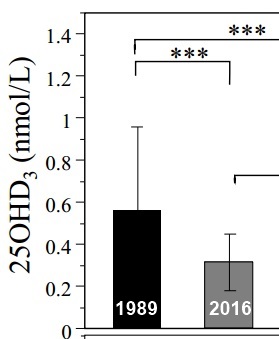Vitamin D levels have dropped in breast milk too (1989-2016)
Comparison of Vitamin D and 25-Hydroxyvitamin D Concentrations in Human Breast Milk between 1989 and 2016–2017
Nutrients 2021, 13(2), 573; https://doi.org/10.3390/nu13020573
Naoko Tsugawa 1,2,*,Mayu Nishino 2,Akiko Kuwabara 3OrcID,Honami Ogasawara 1,Maya Kamao 4OrcID,Shunjiro Kobayashi 5,Junichi Yamamura 5 and Satoshi Higurashi 5
 click on chart for details
click on chart for details
📄 Download the PDF from VitaminDWiki

Background: Breast milk is considered the optimal source of nutrition during infancy. Although the vitamin D concentration in human breast milk is generally considered poor for infants, vitamin D in breast milk is an important source for exclusively breastfed infants. Increases in vitamin D insufficiency and deficiency in lactating mothers may reduce vitamin D concentrations in breast milk. This study aimed to compare vitamin D and 25-hydroxyvitamin D (25OHD) concentrations in breast milk collected in 1989 and 2016–2017 and simultaneously analyze them with liquid chromatography-tandem mass spectrometry (LC-MS/MS); the association between the lifestyle of recent lactating mothers (2016–2017) and vitamin D status in human breast milk was also evaluated.
Method: Lactating mothers were recruited from three regions of Japan in 1989 (n = 72) and 2016–2017 (n = 90), and milk from 3–4 months was collected in summer and winter. The samples were strictly sealed and stored at −80℃ until measurement. Breast milk vitamin D and 25OHD concentrations were analyzed by LC-MS/MS. Vitamin D intake, sun exposure, and sunscreen use of the lactating mothers in 2016–2017 were assessed.
Results: Both vitamin D and 25OHD concentrations in breast milk were higher in the summer regardless of the survey year. Significantly lower vitamin D and 25OHD concentrations were observed in 2016–2017 compared with 1989 in summer, but no survey year difference was observed in winter. The stepwise multiple regression analyses identified season, daily outdoor activity, and suntan in the last 12 months as independent factors associated with vitamin D3 concentrations.
Conclusion: The results suggest that low vitamin D status in recent lactating mothers may have decreased vitamin D and 25OHD concentrations in breast milk compared with the 1980s. These results are helpful for developing public health strategies to improve vitamin D status in lactating mothers and infants.
